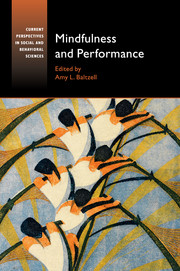Book contents
- Frontmatter
- Dedication
- Epigraph
- Contents
- List of figures
- List of tables
- List of contributors
- Preface
- Acknowledgments
- I INTRODUCTION TO MINDFULNESS: HISTORY AND THEORETICAL UNDERSTANDING
- II FORMAL MINDFULNESS INTERVENTIONS IN SPORT
- III MINDFULNESS: THEORY TO PRACTICE IN SPORT AND EXERCISE
- IV MINDFULNESS AND THE PERFORMING ARTS
- 15 Langerian Mindfulness and Optimal Performance
- 16 Mindfulness and Dancers
- 17 Attention, Centering, and Being Mindful: Medical Specialties to the Performing Arts
- 18 Mindfulness in Music
- V MINDFULNESS FOR COACHES, PRACTITIONERS, AND MENTORS
- VI FUTURE DIRECTIONS
- Index
- References
15 - Langerian Mindfulness and Optimal Performance
from IV - MINDFULNESS AND THE PERFORMING ARTS
Published online by Cambridge University Press: 05 January 2016
- Frontmatter
- Dedication
- Epigraph
- Contents
- List of figures
- List of tables
- List of contributors
- Preface
- Acknowledgments
- I INTRODUCTION TO MINDFULNESS: HISTORY AND THEORETICAL UNDERSTANDING
- II FORMAL MINDFULNESS INTERVENTIONS IN SPORT
- III MINDFULNESS: THEORY TO PRACTICE IN SPORT AND EXERCISE
- IV MINDFULNESS AND THE PERFORMING ARTS
- 15 Langerian Mindfulness and Optimal Performance
- 16 Mindfulness and Dancers
- 17 Attention, Centering, and Being Mindful: Medical Specialties to the Performing Arts
- 18 Mindfulness in Music
- V MINDFULNESS FOR COACHES, PRACTITIONERS, AND MENTORS
- VI FUTURE DIRECTIONS
- Index
- References
Summary
What it takes to optimize sport performance remains a mystery. A Langerian mindfulness approach, an untapped approach to facilitating optimal sport performance, may be an answer for the well-trained athlete to perform his or her best in the present (i.e., moment to moment) in both practice and competition. Pathways to help athletes optimize performance within the sport psychology literature are predominantly past- and future-based. The majority of such interventions are focused on helping athletes cope with sport-related anxiety, to re-create past best performance states and to replicate precursors to flow (a fully engaged, autotelic experience). Mental skills training (e.g., self-talk cues, imagery) is used to help the athlete practice re-creating past experiences in the hopes of reexperiencing (such optimal past scenarios) in the future performances.
There remains little guidance, within the academic sport psychology literature, in terms of what the athlete should focus on in the moment beyond sport psychologists urging athletes to focus on sport-relevant cues. And such emphasis for athletes, on sport-relevant cues, relies heavily on what it was like before in a best performance or a focus on general, static cues (e.g., tennis players keeping their eye on the ball; long-distance runners tuning into the rhythm of running when the pain sets in). Although often effective, that approach seems to be forgetting a fundamental aspect of performance.
The problem, of course, is that each practice and each performance is unique. Athletes are never exactly now as they were, and, of course, the environment, conditions, expectations, and competitors are never exactly as they were. This chapter will provide an understanding of how a Langerian mindfulness approach to sport psychology consulting could augment the typical approach to helping athletes optimize performance and provide a direct pathway to enhancing performance by noticing novelty within sport- and performance-relevant cues to help create flow (fully engaged experiences) and augment concentration in the moment-to-moment experience.
Many years ago, I had the joy of having Gregorio Di Leo, world-class Italian kickboxer, in one of my graduate sport psychology courses. He asked a question once that has remained seared in my memory. After many lectures on talking about what helps an athlete optimize performance, including lectures on goal setting, visualization, arousal regulation, and self-talk (intrapersonal intentional, often scripted self-statements), he passionately asked, “How do I know what my best performance looks or feels like? Maybe I haven't had it yet.” I was stumped.
- Type
- Chapter
- Information
- Mindfulness and Performance , pp. 349 - 366Publisher: Cambridge University PressPrint publication year: 2016
References
- 1
- Cited by

